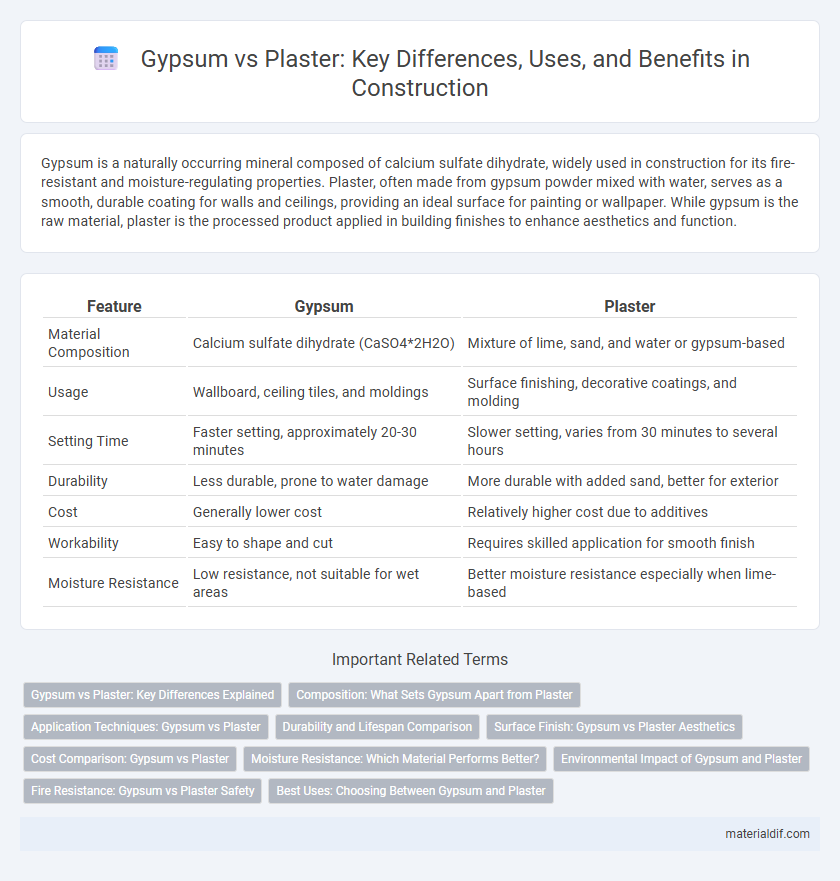Gypsum is a naturally occurring mineral composed of calcium sulfate dihydrate, widely used in construction for its fire-resistant and moisture-regulating properties. Plaster, often made from gypsum powder mixed with water, serves as a smooth, durable coating for walls and ceilings, providing an ideal surface for painting or wallpaper. While gypsum is the raw material, plaster is the processed product applied in building finishes to enhance aesthetics and function.
Table of Comparison
| Feature | Gypsum | Plaster |
|---|---|---|
| Material Composition | Calcium sulfate dihydrate (CaSO4*2H2O) | Mixture of lime, sand, and water or gypsum-based |
| Usage | Wallboard, ceiling tiles, and moldings | Surface finishing, decorative coatings, and molding |
| Setting Time | Faster setting, approximately 20-30 minutes | Slower setting, varies from 30 minutes to several hours |
| Durability | Less durable, prone to water damage | More durable with added sand, better for exterior |
| Cost | Generally lower cost | Relatively higher cost due to additives |
| Workability | Easy to shape and cut | Requires skilled application for smooth finish |
| Moisture Resistance | Low resistance, not suitable for wet areas | Better moisture resistance especially when lime-based |
Gypsum vs Plaster: Key Differences Explained
Gypsum is a natural mineral composed primarily of calcium sulfate dihydrate, widely used in construction for its fire-resistant and moisture-regulating properties, while plaster typically refers to a mixture of gypsum, lime, or cement with water for coating walls and ceilings. Gypsum products are generally easier to install, offer better insulation, and dry faster compared to traditional plaster, which tends to be harder and more brittle once set. The key differences between gypsum and plaster include their chemical composition, setting time, durability, and moisture resistance, making gypsum preferred for modern drywall applications and plaster favored for decorative finishes and repair work.
Composition: What Sets Gypsum Apart from Plaster
Gypsum primarily consists of calcium sulfate dihydrate, which provides unique properties such as fire resistance and ease of workability, distinguishing it from plaster made largely of lime or cement. The hydration process in gypsum allows it to harden quickly, creating a smooth, durable surface ideal for interior finishes. Unlike plaster, gypsum's chemical composition reduces cracking and improves moisture resistance, making it a preferred choice in modern construction and decorative applications.
Application Techniques: Gypsum vs Plaster
Gypsum is primarily applied in powder form mixed with water to create a smooth, fast-setting surface ideal for sculpting and detailed finishing, while plaster often requires multiple layers and longer curing times for durability. Gypsum's setting process allows for quicker application and sanding, making it suitable for interior walls and decorative elements, whereas plaster's application techniques emphasize strength and moisture resistance, beneficial for exterior and wet areas. The choice between gypsum and plaster depends on the specific project requirements, such as drying time, surface finish, and environmental conditions.
Durability and Lifespan Comparison
Gypsum boards offer superior durability compared to traditional plaster, as they resist cracking and moisture damage more effectively, making them ideal for long-term structural applications. Plaster, while providing a smooth and hard finish, tends to be more susceptible to chipping and requires more frequent maintenance over time. The average lifespan of gypsum boards can exceed 30 years under proper conditions, whereas plaster walls may deteriorate faster, especially in high-humidity environments.
Surface Finish: Gypsum vs Plaster Aesthetics
Gypsum offers a smoother and more uniform surface finish compared to traditional plaster, making it ideal for modern interior aesthetics. Its fine texture minimizes imperfections, resulting in sleek walls with enhanced light reflectivity. Plaster, while durable, often exhibits a rougher finish that adds character but requires more labor for a polished look.
Cost Comparison: Gypsum vs Plaster
Gypsum typically costs less than traditional plaster due to its faster installation time and lower labor expenses, making it a more economical choice for large projects. Plaster, while often more expensive, provides greater durability and a smoother finish, potentially reducing maintenance costs over time. The overall cost difference depends on project size, complexity, and regional labor rates, with gypsum offering a cost-effective solution for budget-conscious construction.
Moisture Resistance: Which Material Performs Better?
Gypsum and plaster differ significantly in moisture resistance, with gypsum offering enhanced moisture control due to its natural composition and additives that improve water repellency. Plaster, often composed of lime or cement-based materials, tends to absorb more moisture, making it less suitable for damp environments. Consequently, gypsum is preferred in areas prone to humidity, such as bathrooms and basements, because it maintains structural integrity and prevents mold growth better than traditional plaster.
Environmental Impact of Gypsum and Plaster
Gypsum, a naturally occurring mineral, has a lower environmental impact compared to traditional plaster due to its abundant availability and recyclability, which reduces the need for energy-intensive processing. Plaster production often involves synthetic additives and higher CO2 emissions, contributing to greater ecological footprint and resource depletion. The eco-benefits of gypsum include minimal waste generation and its ability to be recycled multiple times, promoting sustainable building practices.
Fire Resistance: Gypsum vs Plaster Safety
Gypsum offers superior fire resistance due to its chemically bound water, which releases steam when exposed to heat, slowing fire spread and enhancing building safety. In contrast, traditional plaster lacks this inherent fire-resistant property, making gypsum a safer choice in fire-prone environments. Building codes often prioritize gypsum drywall for fire-rated walls, highlighting its critical role in passive fire protection.
Best Uses: Choosing Between Gypsum and Plaster
Gypsum, a natural mineral primarily used in drywall production, excels in fire resistance and soundproofing, making it ideal for modern interior walls and ceilings. Plaster, composed of lime or cement and applied wet, offers superior surface smoothness and is preferred for decorative finishes and detailed moldings. Selecting gypsum is best for speed and ease of installation, while plaster suits projects requiring intricate textures and durability in historic restoration.
Gypsum vs Plaster Infographic

 materialdif.com
materialdif.com